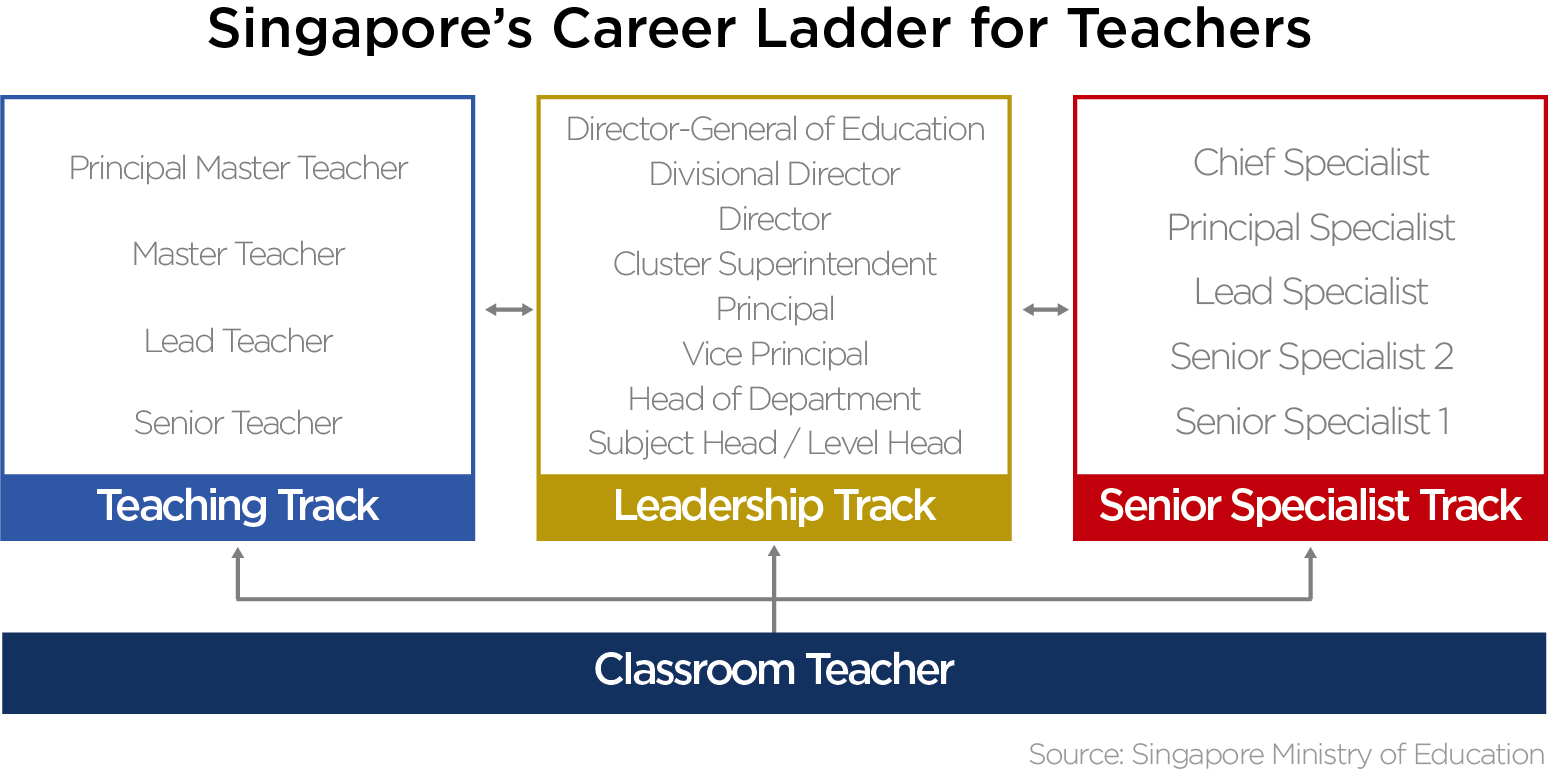
The following piece on Singapore’s educator career ladder is authored by Qidong ‘Alan’ Yang, a Senior Teacher of English Language for primary school students in Singapore. In Singapore, all educators—teachers, leaders and ministry specialists—are part of a single career progression system. To read more about how top-performing education systems assure an abundant supply of highly capable teachers and leaders, visit our policy brief pages.
By: Qidong ‘Alan’ Yang
Seven years ago, I made a decision which would have a far-reaching impact on my career as a teacher.
During the Annual Posting Exercise (APEX), when teachers in Singapore can make their request to shift positions to a posting in the Singapore Ministry of Education (MOE) Headquarters Divisions, another school, deployment to organizations outside MOE such as private institutes and schools, or even a posting to another ministry, one advertisement stood out.
It called for interested teachers who were “dynamic” and keen on “taking on the challenges” of setting up and establishing a primary school from scratch. Although I was on the teaching track, one of three possible career tracks on which Singapore’s teachers may embark, I decided to move to the leadership track by applying to become a Physical Education Coordinator in the new school.
 The leadership track provides opportunities for teachers to take on leadership positions in schools and the Ministry’s headquarters. Teachers are assessed annually for performance and leadership potential, and those thought to have leadership potential are offered opportunities and appointments to gain leadership experiences and professional development appropriate for their portfolios.
The leadership track provides opportunities for teachers to take on leadership positions in schools and the Ministry’s headquarters. Teachers are assessed annually for performance and leadership potential, and those thought to have leadership potential are offered opportunities and appointments to gain leadership experiences and professional development appropriate for their portfolios.
Knowing I was relatively inexperienced in assuming this new leadership position, my supervisor and school administrators at the new school were very generous with their time with me and spelled out their expectations and goals for me through regular informal meetings as well as more formal periodic work reviews. The plethora of professional development (PD) opportunities and teacher-sharing sessions available through Singapore’s National Institute of Education (NIE) and the Academy of Singapore Teachers (AST) made my new shoes easier to fill. NIE is Singapore’s teacher training and research institution and AST is the nation’s teacher-led professional development organization.
Singapore teachers assuming appointments on the career tracks are not left to their own devices to search for, and sign up for appropriate PD initiatives and programs, but join an ever-growing fraternity of experienced peers and alumni in a carefully-planned, comprehensive suite of programs. Teachers on the teaching track participate in the Teacher Leaders Programme (TLP), while teachers on the leadership track may enroll in the Leadership Programmes, with all course fees borne by the ministry, and fully-salaried for the entire duration of the program. The TLP equips teachers with the skills to innovate in their classrooms and schools, and better mentor their colleagues. The Leadership Programmes focus on developing the ability of participants to manage school organizations in a fast-paced and unpredictable environment, while driving teaching and learning excellence through the development of both human and intellectual capitals.
In addition, the Teacher Growth Model (TGM) guides PD and learning for all Singapore teachers based on five learning outcomes: 1) the Ethical Educator, 2) the Competent Professional, 3) the Collaborative Learner, 4) the Transformational Leader and 5) the Community Builder, with competencies further elaborated upon within the model. Themed programs and courses tied to each outcome and competency are available for teachers to participate in, and teachers have the autonomy to select the area(s) they would like to develop in and participate in corresponding PD activities.
However, despite the continued support, one year into my appointment, a different track called to me.
I felt that returning to the teaching track would be a better fit, with opportunities oriented towards teachers who are keen to further develop the pedagogical capability of the teaching force. The teaching track would allow me to continue learning and developing as an educator, and share my pedagogical experience with other teachers without becoming an administrator.
I expressed my interest to return to the teaching track and be considered for the position of a Senior Teacher. My school administrators subsequently discussed with me the differences in professional job scopes between both the leadership and teaching tracks and the requirements to be formally appointed as a Senior Teacher, the first step on the teacher track after becoming a full-time, licensed teacher. In no meeting was I discouraged, nor made to feel I was making a wrong choice.
My lateral transfer from the leadership track to the teaching track, and intention to be appointed to the position of a Senior Teacher was not a career move I had to make alone without support. My school administrators guided and advised me on the new requirements I had to consider and fulfill to be appointed. This included, for instance, creation and maintenance of a professional portfolio which consists of my personal teaching beliefs and statement, programs and courses which I have attended or conducted, and evidence and data satisfying accreditation standards.
A year later, with the guidance of my supervisors, and multiple cycles of reflection and honing of my craft on my part, they nominated me for an interview. Now, three years after the appointment, and holding the position of Senior Teacher (English Language), I have found a role which draws on my strengths to contribute better by collaborating with my colleagues from the leadership track to strengthen the learning of our pupils, and the pedagogical development and growth of our fellow teachers.
With more experience and growth, I can look forward to being mentored by master teachers, and assume the appointment of a Lead Teacher, followed by a Master Teacher, and ultimately, a Principal Master Teacher: all appointments which make me a teacher leader who is capable of contributing pedagogical knowledge and expertise to my profession and supporting the work of schools nationally.
My career track and progression is still not cast in stone, however. Should I feel I would like another opportunity in a leadership position, or even educational development at the Ministry, I may request to be considered for a lateral transfer to the leadership or senior specialist track respectively.
One may balk at the thought of teachers requesting switches of career tracks throughout their careers, and nominating themselves to be considered for appointment to a higher positions, but recent initiatives by the Ministry of Education have encouraged teachers who are interested in assuming higher positions, to be upfront and open about their desired career progression, instead of waiting to be identified by their school administrators.
Singapore’s clearly-defined and articulated career tracks have led to the development and retention of teaching talent based on individual interests and abilities and is an integral part of the human capital system in our country’s high-performing education system. Leadership is not only distributed, but teachers are allowed to assume important roles in enhancing the capacity of their fellow teachers in various ways in each track.
While career track progression in some countries may possibly be more formal, linear, and static, Singapore’s career tracks are fluid and take into consideration that teachers’ roles, competencies, and capacities to share their skills evolve as they develop in their career. The career track system equips teachers with the knowledge and support system to progress in the profession, and builds the competencies and potential they need to demonstrate to move ahead.
The Singapore career track system has facilitated the career-advancement of teachers like me without requiring me to leave the classroom. I have benefitted from the structures which have enabled me to use my experience to support other teachers and participate in knowledge-creation, capacity-building and professional development.
While some may view my career track transfers as not ideal, the teaching track and my appointment as Senior Teacher has provided me with opportunities to come full circle on the PD continuum. In my present career path, I support and mentor beginning teachers, and help contribute to the learning and growth of my colleagues in their careers, having widened my perspectives and experiences in a variety of settings and career development opportunities.
Eventually, when these teachers are presented with advancement opportunities in their respective career tracks, I look forward to be able to help them continue their professional and personal learning and growth – a process which has been all the more enriching due to the opportunities the Singapore teaching career tracks have afforded me.
Qidong ‘Alan’ Yang is a Senior Teacher of English Language for primary school students in Singapore





